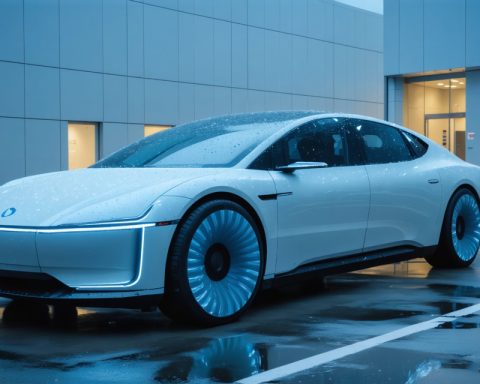- Solid-state lithium metal batterier, især dem der bruger LLZO elektrolytter, står over for udfordringer med at overgå nuværende lithium-ion teknologier.
- Forbedringer i energitæthed med LLZO er marginale, idet de kun stiger lidt fra 270 Wh/kg til 272 Wh/kg.
- LLZO’s tunge vægt og komplekse fremstillingsproces hindrer dens udbredte anvendelse og skalerbarhed.
- På trods af sine begrænsninger tilbyder LLZO uovertruffen sikkerhed og stabilitet i batteriteknologi.
- Hybrid batteriteknologier, der kombinerer LLZO med polymerer eller væsker, præsenterer en lovende vej til forbedret ydeevne og fremstillingsmuligheder.
- Fremtiden for energilagring ligger i at udforske tilpasningsdygtige, hybride løsninger i stedet for kun at stole på nuværende solid-state fremskridt.
Dawn breaks over the landscape of energy storage, and as the sun climbs higher, the promises of solid-state lithium metal batteries appear less dazzling than we once imagined. A recent exploration into the potential of garnet-type electrolytes, specifically LLZO, sheds new light on this technology, suggesting that perhaps the future is not as crystal clear—or as promising—as it seemed.
Renowned for its stability and efficient lithium-ion conduction, LLZO once shone like a beacon of hope in the quest for energy solutions. Yet, a deep dive into its capabilities reveals a somewhat dimmed potential: marginal energy density improvements over current lithium-ion champions, inching slightly to 272 Wh/kg from a previous high of 270 Wh/kg. The once-solid promises of substantial leaps in energy efficiency now seem, at most, modest hops.
Why do these gains appear so scant? The culprit lies in LLZO’s weight and the hurdles of its manufacture. Contribution to weight makes it a heavyweight in the world of batteries, consumed by its own density. Added to this are the not-insignificant costs and intricate technological snags tied to its production, hindering the airy dreams of expansive deployment.
Even with the foresight of minimal energy gains, LLZO does maintain a solid stance in one arena: safety. Its intrinsic stability remains unparalleled. But the roadblocks to wider use—the brittleness, the heavy footprint, and the persistent specter of lithium dendrites—paint a less-than-ideal picture for scalability. Its weight treads heavily on the pathway to progress, while its production complexities deepen the chasm between potential and realization.
In this revelation, researchers pivot their gaze to hybrid vistas. Imagine a landscape where LLZO merges with polymers or liquids into composite forms, shedding constraints while retaining the powerful core of solid-state technology. These hybrids don’t just offer a slimmer silhouette; they promise manufacturability and structural tenacity, allowing for long-haul stability without the bulk. This hybrid vision draws closer to the sweet spot where flexibility meets high performance, leaving behind the heaviness of full-solid forms.
As the journey for energy innovation continues, the lesson is clear: We may need to reconstruct our roadmaps. The future is not merely about chasing shiny promises but understanding the terrain and paving realistic paths forward. By blending the best of different worlds, we might yet harness the energy of expectation and channel it into breakthrough realities.
Revolutionizing Energy Storage: The Untapped Potential of Hybrid Solid-State Batteries
The quest for next-generation energy storage solutions has placed solid-state lithium metal batteries at the forefront. However, recent insights into garnet-type electrolytes, particularly lithium lanthanum zirconium oxide (LLZO), reveal that the journey is not as straightforward as once thought. Let’s explore deeper into this evolving field, highlighting the potential, limitations, and future directions for solid-state battery technology.
Why LLZO’s Promise Falls Short
1. Energy Density Limits: LLZO offers marginal improvements in energy density, moving only slightly from 270 Wh/kg to 272 Wh/kg. This poses a significant limitation for applications where enhanced energy density is crucial, such as electric vehicles.
2. Manufacturing Complexities: The production process for LLZO is costly and technologically intricate, discouraging mass-market adoption. Techniques like sintering at high temperatures increase production costs and complicate scalability.
3. Weight and Brittleness: The substantial weight of LLZO batteries, combined with their brittleness, affects their utility in portable applications. This limits their deployment to sectors where weight is a critical factor.
Hybrid Approaches: A Promising Horizon
– Blending with Polymers or Liquids: By integrating LLZO with polymers or liquid electrolytes, researchers aim to create composite batteries that maintain stability while reducing weight and improving flexibility. These hybrids could offer an optimal balance between the safety of solid-state batteries and the flexibility of liquid-based systems.
– Structural Stability: Hybrids potentially provide greater manufacturability and durability, addressing LLZO’s brittleness by incorporating flexible materials.
Real-World Use Cases & Future Trends
– Electric Vehicles (EVs): As the automotive industry pivots toward electric solutions, hybrid solid-state batteries might offer a viable path for EVs, combining safety with acceptable energy densities.
– Portable Electronics: Smaller, lighter batteries could revolutionize portable electronics, making them more efficient and safer.
– Energy Storage Systems: For grid energy storage, where safety and longevity are paramount, LLZO-based hybrids could play a pivotal role.
Market Forecast & Industry Trends
– Investments in Research: Significant resources are being directed towards developing hybrid battery technologies, with industry leaders and startups alike pushing the boundaries of what’s possible.
– Shift to Sustainability: As environmental concerns gain traction, the demand for more sustainable battery production processes will drive innovation in this space.
Challenges and Controversies
– Initial Costs: While hybrid batteries promise long-term benefits, the initial high costs of research and development may be a barrier for widespread adoption.
– Lithium Dendrite Formation: Tackling lithium dendrite formation remains a key research focus, as it affects battery safety and efficiency.
Actionable Recommendations
1. Invest in Research: Organizations should invest in R&D for hybrid battery technologies to overcome current barriers and capitalize on future market opportunities.
2. Focus on Safety: Firms can prioritize applications where safety is non-negotiable, leveraging the intrinsic stability of solid-state batteries.
3. Collaborative Innovation: Companies should engage in cross-sector collaborations to accelerate technological advancements and market readiness.
By understanding these complexities and opportunities, stakeholders can make informed decisions to drive innovation in energy storage. To learn more about emerging technologies and sustainability trends, visit ResearchGate.















